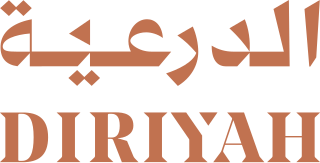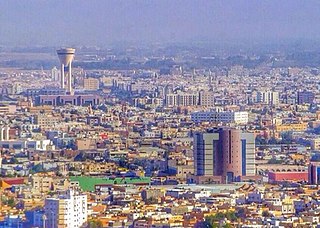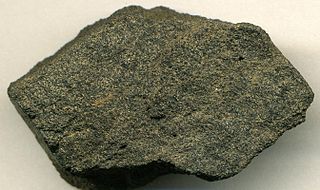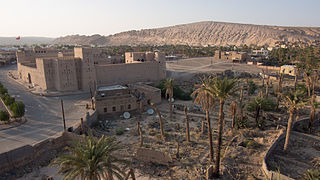Related Research Articles

The Kingdom of Saudi Arabia is a country situated in West Asia, the largest country on the Arabian Peninsula, bordering the Persian Gulf and the Red Sea. Its extensive coastlines provide great leverage on shipping through the Persian Gulf and the Suez Canal. The kingdom occupies 80% of the Arabian Peninsula. Most of the country's boundaries with the United Arab Emirates (UAE), Oman, and the Republic of Yemen are undefined, so the exact size of the country remains unknown. The Saudi government estimate is at 2,217,949 square kilometres, while other reputable estimates vary between 2,149,690 and 2,240,000 sq. kilometres. Less than 7% of the total area is suitable for cultivation, and in the early 1960s, population distribution varied greatly among the towns of the eastern and western coastal areas, the densely populated interior oases, and the vast, almost empty deserts.

Najd is the central region of Saudi Arabia, in which about a third of the country's modern population resides. It is the home of the House of Saud, from which it pursued unification with Hejaz since the time of the Emirate of Diriyah.

Ghawar is an oil field located in Al-Ahsa Governorate, Eastern Province, Saudi Arabia. Measuring 280 by 30 km, it is by far the largest conventional oil field in the world, and accounts for roughly a third of the cumulative oil production of Saudi Arabia as of 2018.

Diriyah, formerly romanized as Dereyeh and Dariyya, is a town and governorate in Saudi Arabia. Located on the northwestern outskirts of the Saudi capital, Riyadh. Diriyah was the original home of the Saudi royal family, and served as the capital of the Emirate of Diriyah under the first Saudi dynasty from 1727 to 1818. Today, the town is the seat of the Diriyah Governorate, which also includes the villages of Uyayna, Jubayla, and Al-Ammariyyah, among others—and is part of Ar Riyad Province.

Tabuk is the capital city of the Tabuk Region in northwestern Saudi Arabia. It has a population of 594,350. It is close to the Jordan–Saudi Arabia border and houses the largest air force base in Saudi Arabia.

Phosphorite, phosphate rock or rock phosphate is a non-detrital sedimentary rock that contains high amounts of phosphate minerals. The phosphate content of phosphorite (or grade of phosphate rock) varies greatly, from 4% to 20% phosphorus pentoxide (P2O5). Marketed phosphate rock is enriched ("beneficiated") to at least 28%, often more than 30% P2O5. This occurs through washing, screening, de-liming, magnetic separation or flotation. By comparison, the average phosphorus content of sedimentary rocks is less than 0.2%.

Vale, formerly Companhia Vale do Rio Doce, is a Brazilian multinational corporation engaged in metals and mining and one of the largest logistics operators in Brazil. Vale is the largest producer of iron ore and nickel in the world. It also produces manganese, ferroalloys, copper, bauxite, potash, kaolin, and cobalt; as of 2014 the company operated nine hydroelectricity plants, and a large network of railroads, ships, and ports used to transport its products.

The Arabian-Nubian Shield (ANS) is an exposure of Precambrian crystalline rocks on the flanks of the Red Sea. The crystalline rocks are mostly Neoproterozoic in age. Geographically – and from north to south – the ANS includes parts of Israel, Jordan, Egypt, Saudi Arabia, Sudan, Eritrea, Ethiopia, Yemen, and Somalia. The ANS in the north is exposed as part of the Sahara Desert and Arabian Desert, and in the south in the Ethiopian Highlands, Asir province of Arabia and Yemen Highlands.

Ibri is a city and Wilāyat (Province) in the Ad Dhahirah Governorate, in northwest Oman.

Charles Wesley Robinson was an American entrepreneur who was involved with many successful business adventures in the mining and shipping industry. He also served as United States Deputy Secretary of State. He was president of CBTF Co. and M Ship Co., a board member of Nike and Chairman of Nike's Finance Committee.
Bisha could refer to one of the following.
Wadi al-Dawasir Domestic Airport is an airport serving Wadi al-Dawasir, a town in Riyadh Province, Saudi Arabia. The airport was established in 1990.

Ralph Jackson Roberts (1911–2007) was an American geologist and research scientist with the USGS. He is credited with the discovery of the Carlin and Battle Mountain Gold Belts, which make up the richest gold-mining region in Nevada as well as the United States.
Wadi Al Dawasir is a city in Najd, Saudi Arabia, in the Dawasir valley. The region is the homeland of the tribe of Al-Dawasir, the name Dawasir derives from the Arabic word 'Dawsar', the most prominent meaning of that word is Steel Lion. The governorates had a population of 91,535 at the 2022 Census. It is divided into three main neighborhoods: Alnowaima, Alkhamaseen and Allidam.

The Hijaz Mountains (Arabic: جِبَال ٱلْحِجَاز, romanized: Jibāl al-Ḥijāz or "Hejaz Range" is a mountain range located in the Hejazi region of western Saudi Arabia. The range runs north and south along the eastern coast of the Red Sea, and can thus be treated as including the Midian Mountains, and being part of the Sarawat Mountains, broadly speaking.

EnergyinSaudi Arabia involves petroleum and natural gas production, consumption, and exports, and electricity production. Saudi Arabia is the world's leading oil producer and exporter. Saudi Arabia's economy is petroleum-based; oil accounts for 90% of the country's exports and nearly 75% of government revenue. The oil industry produces about 45% of Saudi Arabia's gross domestic product, against 40% from the private sector. Saudi Arabia has per capita GDP of $20,700. The economy is still very dependent on oil despite diversification, in particular in the petrochemical sector.
The geology of Saudi Arabia includes Precambrian igneous and metamorphic basement rocks, exposed across much of the country. Thick sedimentary sequences from the Phanerozoic dominate much of the country's surface and host oil.
References
- ↑ "Wadi Sawawin". londonmining.com. 2013. Retrieved 2013-06-29.